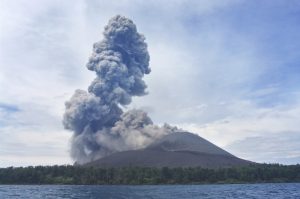
How did the eruptions of Katmai, Taupo and Santorini grow into a massive blast that spewed fine ash, sulfur and crystal-poor magma into the atmosphere? New research from Georgia Institute of Technology and Eidgenössische Technische Hochschule Zurich (ETH) suggests they occurred due in part to how light vapor bubbles migrate and accumulate in some parts of shallow volcanic chambers. The findings are published online by Nature.
Volcanic chambers are a maze of crystal-rich and crystal-poor regions, especially in the last place where magma stalls and builds before eruption. The Georgia Tech-ETH team used lab experiments and computer models to focus on how bubbles move to and through these shallow reservoirs, which are typically about three to five miles below the surface.
“We know that bubbles control the style and power of eruptions, but we don’t fully understand how they behave,” said Georgia Tech Assistant Professor Christian Huber, a faculty member in the School of Earth and Atmospheric Sciences. “It’s probably like opening a soda and watching the bubbles race to the top of the bottle.”
According to their study, Huber and his colleagues believe these bubbles maneuver their way through crystal filled magma until they settle in these open-spaced reservoirs — areas without many crystals — and build up the necessary energy for an impending eruption.
“When we started this project, we thought that the bubbles, as they moved through compact, crystal-rich areas, would be significantly slowed down on their way to the reservoirs,” said Huber. “Instead, these seem to be the best conditions for their ascent through the chamber.”
The team’s experiments indicate that bubbles squeeze through the narrow openings to create finger-like paths. These long paths allow the bubbles to merge and form connected pathways that transport low density vapor efficiently through the crystal-rich parts of magma chambers.
“Once they reach the end of this crystal-rich area and get more space, the water vapor fingers transform back into their usual, spherical bubble shape,” said Andrea Parmigiani, who led the study during his postdoctoral work in Huber’s group at Georgia Tech and in Olivier Bachmann’s group at ETH. “Once vapor forms these bubbles, the ascent of the light vapor bubbles is slow and bubbles accumulate.”
The team says the bubbles, once free to move around in their natural, spherical shape, settle into crystal-poor areas of the reservoir. That’s where their accumulation provides additional potential energy that can drive large volcanic eruptions that release large amounts of sulfur to the atmosphere and result in voluminous crystal-poor deposits.
The Georgia Tech team also included Salah Faroughi and Yanqing Su, who are both co-authors on the paper and Ph.D. candidates in Huber’s group. Faroughi’s lab experiments demonstrated the accumulation of bubbles in the crystal-poor areas. Su’s calculations measured sulfur releases.
Video
Reference:
A. Parmigiani, S. Faroughi, C. Huber, O. Bachmann & Y. Su. Bubble accumulation and its role in the evolution of magma reservoirs in the upper crust. DOI:10.1038/nature17401
Note: The above post is reprinted from materials provided by Georgia Institute of Technology.










